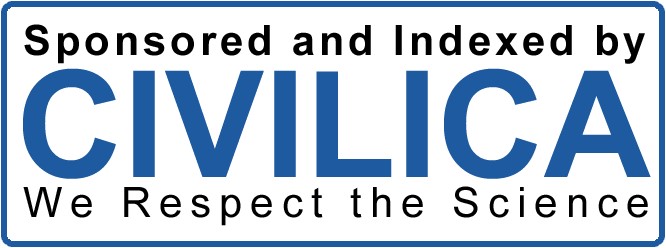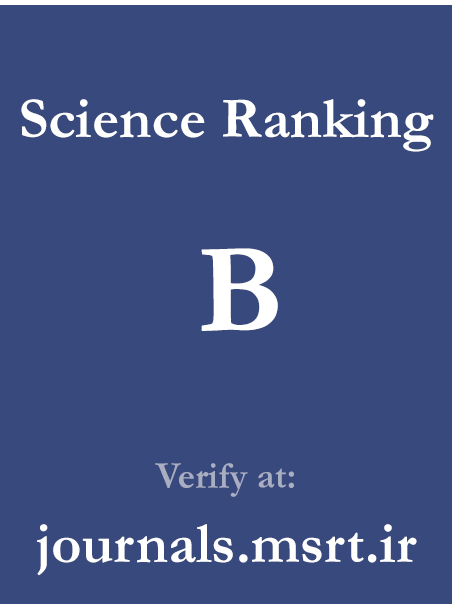Designing an Electronic Citizen Relationship Management Model in the Social Security Organization Based on the S-O-R Approach
Keywords:
electronic customer relationship management (E-CRM); citizen; Stimulus–Organism–Response (S-O-R) approach.Abstract
The purpose of the present study is to design a model of electronic citizen relationship management in the Social Security Organization using the S-O-R (Stimulus–Organism–Response) approach (case study: Social Security Organization). In this regard, after reviewing the concepts of electronic customer relationship management, the notion of citizenship, and the Stimulus–Organism–Response framework, a qualitative method was employed to identify the indicators and components of the electronic relationship management model and to design the proposed framework. The study population consisted of experts and university professors in the fields of management and marketing. A sample of 10 experts in this domain was selected using the snowball sampling method. Data collection was conducted through expert interviews using the Delphi technique. Data analysis was performed through coding procedures in MAXQDA software. The findings revealed that the electronic citizen relationship management model in the Social Security Organization based on the S-O-R approach includes five main themes, six subthemes, and forty final indicators confirmed by experts. These themes include: (1) marketing strategies; (2) environmental factors (website); (3) external organizational factors (social and cultural, economic); (4) perceived experience (perceived value, perceived quality, perceived security, and perceived ease of use); and (5) citizens’ behavioral responses and reactions (e-loyalty, interactions, and information sharing).
Downloads
References
Agrawal, A., Gans, J., & Goldfarb, A. (2017). What to expect from artificial intelligence. NBER Working Paper. https://doi.org/10.3386/w24690
Akour, I., Alshurideh, M., Al Kurdi, B., Al Ali, A., & Salloum, S. (2021). Using machine learning algorithms to predict people's intention to use mobile learning platforms during the COVID-19 pandemic: machine learning approach. Jmir Medical Education, 7(1), e24032. https://doi.org/10.2196/24032
Allen, B., Tamindael, L. E., Bickerton, S. H., & Cho, W. (2019). Does citizen coproduction lead to better urban services in smart cities projects? An empirical study on e-participation in a mobile big data platform. Government Information Quarterly, 101412. https://doi.org/10.1016/j.giq.2019.101412
Alshurideh, M. (2022). Does electronic customer relationship management (E-CRM) affect service quality at private hospitals in Jordan? Uncertain Supply Chain Management, 10(2), 325-332. https://doi.org/10.5267/j.uscm.2022.1.006
Alshurideh, M., Al Kurdi, B., Salloum, S. A., Arpaci, I., & Al-Emran, M. (2020). Predicting the actual use of m-learning systems: a comparative approach using PLS-SEM and machine learning algorithms. Interactive Learning Environments, 1-15. https://doi.org/10.1080/10494820.2020.1826982
Arabshahi, M., & Abbaszadeh, H. (2023). The Impact of Electronic Customer Relationship Management on Marketing Performance: Analyzing the Mediating Role of Product Innovation and Emphasizing Customer Knowledge. Value Creation in Business Management, 3(2), 42-61. https://www.jvcbm.ir/article_176721.html
Aria, F. T., & Dafoulas, G. (2023). Introducing a Conceptual Model for Electronic Customer Relationship Management Readiness in the Banking Sector. International Journal of Business and Technology Management, 5(2), 127-136.
Babaahmadi Tangagazi, M., & Karrahi Moghadam, S. (2020). Identifying and Presenting a Model of Barriers to the Implementation of Electronic Insurance Services (Case Study: Health Insurance in Ahvaz). Journal of the Faculty of Medicine, Mashhad University of Medical Sciences, 63(2), 2455-2469. https://mjms.mums.ac.ir/article_19566.html
Bikzad, J., & Jalili Nejad, G. (2021). Pathology of Digital Governance in Electronic Government. Journal of Engineering Sciences and Technology, 6(6), 17-33. https://sid.ir/paper/968222/fa
Chen, J., Huang, Y., Wu, E. Q., Ip, R., & Wang, K. (2023). How does rural tourism experience affect green consumption in terms of memorable rural-based tourism experiences, connectedness to nature and environmental awareness? Journal of Hospitality and Tourism Management, 54, 166-177. https://doi.org/10.1016/j.jhtm.2022.12.006
Dehdashti Shahrikh, Z., Nasehifar, V., Mohammadian, M., & Kiaei, M. (2023). Customer experience modeling with theme analysis; In line with customer management in the automotive industry. Consumer Behavior Studies Journal, 9(4), 23-43. https://journals.uok.ac.ir/article_62481.html
Fakhri, F., & Mottahari, M. (2020). The Application of the S-O-R Model in Consumer Behavioral Responses to Retail Brand with a Communication Marketing Approach. Business Management, 1-24. https://civilica.com/doc/1121096/
Guo, S., Li, Y., Hu, Y., Xue, F., Chen, B., & Chen, Z. M. (2019). Embodied energy in service industry in global cities: A study of six Asian cities. Land Use Policy, 104264. https://doi.org/10.1016/j.landusepol.2019.104264
Hashemi, S., Moradi, M., & Asgar Khani, A. M. (2022). Examining the Role of Electronic Government in the Timeliness of Legal Matters and Arbitrations in Iran. Sixteenth Year(58), 257-277. https://www.noormags.ir/view/fa/articlepage/2026699/
Haudi, H., Rahadjeng, E., Santamoko, R., Putra, R., Purwoko, D., Nurjannah, D., & Purwanto, A. (2022). The role of e-marketing and e-CRM on e-loyalty of Indonesian companies during Covid pandemic and digital era. Uncertain Supply Chain Management, 10(1), 217-224. https://doi.org/10.5267/j.uscm.2021.9.006
Heij, C. V., Volberda, H. W., Van den Bosch, F. A., & Hollen, R. M. (2020). How to leverage the impact of R&D on product innovation? The moderating effect of management innovation. R&D Management, 50(2), 277-294. https://doi.org/10.1111/radm.12396
Jabali, A., & Abdi, S. (2020). Social Services and Human Resource Management. Quarterly Journal of Approaches in Business Management, 1(1), 53-65. https://www.sid.ir/paper/521738/fa
Jafari, S. M. B., & Yaghoubi Jahromi, Z. (2018). The Impact of Implementing Social Customer Relationship Management on Customer Relationship Performance. Scientific-Research Journal of Business Management Studies, 10(20). https://civilica.com/doc/916266/
Javadi, E. I. P., & Murwani, I. A. (2022). The Implementation of S-O-R Framework (Stimulus, Organism and Response) in User Behavior Analysis of Instagram Shop Features on Purchase Intention. Scholars Journal of Engineering and Technology, 23-25. https://saspublishers.com/media/articles/SJET_104_42-53_FT.pdf
Kaur, H. (2023). ECRM Practices adopted by Selected Public & Private Banks in Punjab. Finance India, 37(1). https://financeindia.org/data/2023/FI371/FI-371-Abs01.pdf
Khodaami, S., Jafari Nia, S., & Khalili, H. (2020). Examining Customer Participation in Branding on Social Media Based on UGT Theory and the S-O-R Framework. Quarterly Journal of New Marketing Research, 10(4), 55-80. https://nmrj.ui.ac.ir/article_24697.html
Khoram, K., Asadi, I., & Darniani, S. (2021). Factors Effective in the Development of Electronic Government: A Case Study of the Tax Affairs Organization of Tehran Metropolis. Studies in Intelligent Business Management, 10(38), 357-388. https://ims.atu.ac.ir/article_13530.html
Kiani, R. (2021). Investigating the Status of Insurance Coverage and Support Services for the Elderly Worldwide. Scientific-Research Quarterly of Health Insurance in Iran, 4(3). https://www.sid.ir/paper/1021426/fa
Massoud, M., & Al-Dulaimi, N. T. A. (2023). E-CRM A LEVERAGE TOOL FOR CONSUMERS' RETENTION AN ANALYSIS OF IRAQI CONSUMERS' PERSPECTIVE. World Economics and Finance Bulletin, 21, 13-29. https://e-tarjome.com/post/10417
Mohammad Shafiei, M., Sifi, M., & Yazdi, A. (2020). Antecedents and Consequences of Establishing Electronic Customer Relationship Management in Small and Medium Enterprises. New Marketing Research, 10(1), 36. https://nmrj.ui.ac.ir/article_24700.html
Naim, A. (2022). Understanding the customer centric approach to add value to social eCRM (SECRM). American Journal of Technology and Applied Sciences, 3, 17-31. https://www.neliti.com/journals/american-journal-of-technology-and-applied-sciences/browse/all?page=16
Pahrudin, P., Hsieh, T. H., Liu, L. W., & Wang, C. C. (2023). The role of information sources on tourist behavior post-earthquake disaster in Indonesia: A Stimulus-Organism-Response (SOR) approach. Sustainability, 15(11), 8446. https://doi.org/10.3390/su15118446
Peng, W. (2025). The Factors Influencing Impulsive Buying Behavior In Live Streaming Shopping Based On SOR Model. https://jyx.jyu.fi/jyx/Record/jyx_123456789_103835/Cite?sid=189547356
Savira, D. A., Hendrayati, H., & Hurriyati, R. (2022). The Effect of Electronic Customer Relationship Management (eCRM) on Customer Satisfaction. 6th Global Conference on Business, Management, and Entrepreneurship (GCBME 2021), https://doi.org/10.2991/aebmr.k.220701.042
Shah Tahmasbi, I., Mazarei, S., & Lalezar, F. (2019). Market Orientation and New Product Performance: Examining the Moderating Role of Managerial Social Relationships and Implicit Customer Needs. Journal of New Marketing Research, 9(4), 97-114. https://nmrj.ui.ac.ir/article_24644.html
Taghvaifard, M. T., Ghorbani Zadeh, V., & Hejazi Niaz, R. (2019). A Model of Requirements for Establishing Electronic Government Services in the Context of Social Media: Electronic Government. Public Management Research(Winter), 150-170. https://jmr.usb.ac.ir/article_5261.html
Yun, S., Kim, E., Kim, S., & Hong, T. (2023). Does Digital Transformation Accelerate the Acceptance of Social CRM on the Small and Medium Enterprises? 인터넷전자상거래연구, 23(2), 155-172. https://doi.org/10.37272/JIECR.2023.04.23.2.155
Downloads
Published
Submitted
Revised
Accepted
Issue
Section
License
Copyright (c) 2025 Sara Javan Javidan (Author); Amirbabak Marjani (Corresponding author); Farshad Hajalian, Mansoureh Moradi haghighi (Author)

This work is licensed under a Creative Commons Attribution-NonCommercial 4.0 International License.






